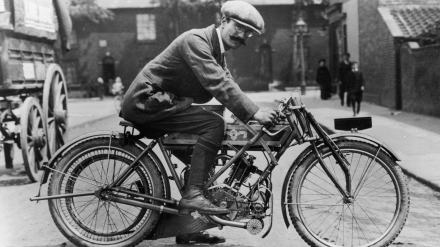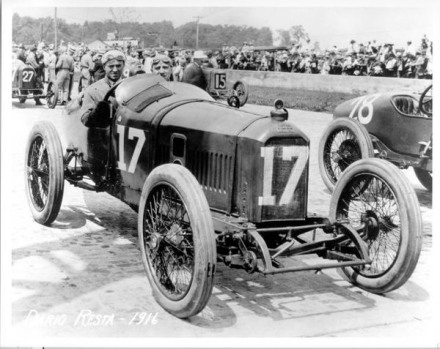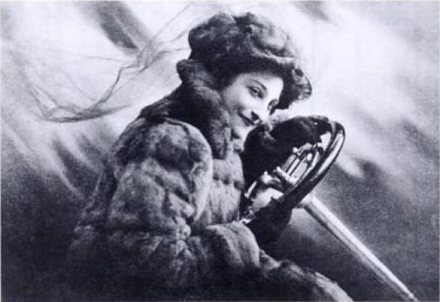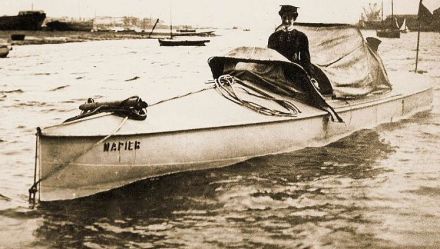Given the somewhat chronic condition in which British motor racing currently finds itself, the S&G has charted the history of the sport through the landmarks that have been reached at home and abroad for the past 120 years.
It appears as though Silverstone is to be reinstated on the FIA World Endurance Championship calendar with an August date for 2018, which is good news. Hopefully the Royal Automobile Club will maintain the Tourist Trophy’s presence at the event – and perhaps even make some good use of its unique stature in the sport!
This series is not intended to be definitive in describing every race or innovation, nor list every adventure and misadventure – merely to provide some landmarks for those who may seek to go back and realise why it is we do what we do. Ours is a sport whose story is ripe with brightness, bravery and joie-de-vivre that has inspired countless millions around the world.
A fact that is all-too-often overlooked today, when the financial comings-and-goings of Formula 1 are all-too-often considered to be the sum total of the sport.
Race on, dear readers. Race on…
1896
- The Royal Automobile Club hosts the Emancipation Run from London to Brighton, celebrating the British motorist’s freedom to travel faster than walking pace.
1902
- Dunlop begins producing specific tyres for racing based upon the experience and observation of international racing events.
- Scottish Automobile Club organises the Glasgow-London non-stop trial
- Selwyn Edge wins the Gordon Bennett Cup, held on the public highways between Paris and Innsbruck, on a Napier. This becomes the first British success in competition.
1903
- As the champion nation, Great Britain hosts the Gordon Bennett Cup on a circuit of closed roads in County Kildare, Ireland.
- City-to-city races are abandoned in continental Europe after a spate of fatal accidents during the Paris-Madrid race.
1904
- The Isle of Man hosts Britain’s Qualifying Race for the Gordon Bennett Cup on a closed road circuit.
- Aston Hillclimb opens on the B4009 passing through the Rothschild estate between Tring and Wendover. Eventually, this road inspires the naming of the Aston Martin motor company.
- The Motor Cycling Club organises the London-Edinburgh Trial
- The inaugural Blackpool Speed Trials is held on the Promenade
1905
- The Isle of Man hosts the inaugural Royal Automobile Club RAC Tourist Trophy, won by John Napier on an Arrol-Johnson.
- Shelsley Walsh holds its first hillclimb event.
- Napier employee Miss Dorothy Levitt sets a record for ‘the longest drive made by a lady’ when she drives an 8hp DeDion from London to Liverpool and back, accompanied by an official observer, her pet Pomeranian dog DoDo and a revolver. She covers 411 miles at an average 20 mph.
- The Motor Cycling Club organises the London-Land’s End Trial
- The inaugural Brighton National Speed Trials take place on a specially-constructed stretch of road which later becomes known as Madeira Drive. Miss Dorothy Levitt wins the award for fastest lady at the event, her 80 hp Napier setting a speed of 79.75 miles per hour
1906
- The inaugural Grand Prix de l’ACF is held at Le Mans, replacing the city-to-city events with a closed road course. No British manufacturers enter after The Motor magazine declares that the event is being organised to glorify French motor manufacturers at the expense of international rivals.
- Charles Rolls wins the RAC Tourist Trophy on a Rolls-Royce.
- Shell begins advertising its Motor Spirit using success in motor sport as its unique selling point – starting with fuelling two successive wins in the RAC Tourist Trophy
- The Motor Cycling Club organises the London-Exeter Trial
- Construction begins on the Brooklands motor circuit near Weybridge.
1907
- The Brooklands Automobile Racing Club is formed and Brooklands hosts its first event: a successful attempt on the 24-hour speed record by Selwyn Edge.
- Shell opens the first purpose-built fuel and oil station for motor racing purposes at Brooklands.
- On Saturday, July 6, Brooklands holds its first open race meeting. The only racing model available for creating a format for the event is that of the Jockey Club, with drivers being identified by their coloured smocks. Selwyn Edge wins the first major race for Napier, the Marcel Renault Memorial Plate, and claims a prize of 400 sovereigns in front of a crowd of 13,500 people. A total of 500 motor cars is estimated to have driven to the race.
- Ernest Courtis wins the RAC Tourist Trophy on a Rover.
- V. Herman becomes the first British driver killed in a motor race, when he fails to negotiate the Members’ Banking at Brooklands
- Mr. V. Herman becomes the first driver killed in a motor race, when he fails to negotiate the Members’ Banking at Brooklands
- Harry ‘Rem’ Fowler wins the senior twin-cylinder class of the inaugural Isle of Man TT on a Norton with a Peugeot engine. Charlie Collier wins the single cylinder class for Matchless.
- At the end of the first Brooklands racing season, the motor manufacturers are graded according to prize money won – with the result being Mercedes in first place then Fiat, Daimler, Napier, Sizaire and Darracq.
1908
- Willy Watson wins the RAC Tourist Trophy on a Hutton-Napier.
- Harry Reed wins the Isle of Man TT twin cylinder race on a Dot Cycle, Jack Marshall wins the single cylinder class for Triumph
- F. Newton sets a new record of 120 mph at Brooklands on his Napier-Samson
1909
- Brooklands hosts the successful 1km Land Speed Record attempt by Victor Hémery, raising the record to 125.9 mph in a Benz
- In an all-comers entry for the Isle of Man TT, victory is taken by Harry A. Collier on a 6hp Matchless
- French aviator Louis Paulhan becomes the first airman to base himself at Brooklands, having been given a roller to flatten out part of the infield to make a runway
1910
- Louis Coatelen reveals the Sunbeam Nautilus: a Land Speed Record car that paves the way for a succession of Sunbeam racing cars.
- Cyril Snipe wins the Modena Sprint on an Italian SPA motor car.
- The Isle of Man TT is won by Charlie Collier, brother of the previous year’s winner Harry, heading home a family 1-2 on Matchless 5hp motorcycles.
- Victor Surridge takes the one hour motorcycle speed record at Brooklands.
- Brooklands ends its regular season by hosting the first Inter-Varsity meeting for motorcycles and cars entered by Oxford and Cambridge students

Harry Collier and his Matchless
1911
- The Isle of Man TT is split into Junior and Senior categories on the new Mountain Course, with the former being won by Percy Evans on a Humber and the main event falling to Oliver Godfrey, making American make Indian the first overseas winner of the race, claiming the top three positions. Victor Surridge is the first rider to be killed at the event.
- While taking the Grand Prix-winning Peugeot L76 on a tour of British dealerships, Dario Resta stops off for dinner with Sunbeam chief engineer Louis Coatalen and the car is stripped by Sunbeam designers and engineers, who study, sketch and reassemble it by the time that Resta continues on his way. A dark green Sunbeam grand prix car duly appears soon afterwards, bearing more than a passing resemblance to the French car.
- Brooklands hosts its first air race to Hendon and back. Thereafter air racing and motor racing often share the bill in the course of the regular racing season.
1912
- Sunbeam finishes 1st, 2nd and 3rd at the Coupe de l’Auto.
- British driver Cyril Snipe wins the Targa Florio in Sicily at the wheel of the Italian SCAT motor car.
- The Cyclecar Club is formed at Brooklands to organise races for small cars and motorcycles.
- Frank Applebee wins the Isle of Man TT senior race on a Scott motorcycle, W.H. Bashall winning the junior race for Douglas

Sunbeam’s team lines up for the Coupe l’Auto
1913
- Craigantlet hillclimb holds its first event.
- Percy E. Lambert becomes the first man to drive 100 miles in one hour, setting the record at Brooklands on a 4.5-litre side-valve Talbot.
- Scott wins its second Isle of Man TT senior race in the hands of H.O. ‘Tim’ Wood. Hugh Mason on a NUT wins the junior race. Frank Bateman becomes the second rider killed competing in the TT.
- Percy Lambert is killed in the last race meeting of the season at Brooklands.
1914
- Brooklands hosts the successful 1-mile Land Speed Record attempt by Lydston Hornsted, raising the record to 124.09 mph in a Benz.
- Second inter-Varsity race meeting held for students of Oxford and Cambridge
- Kenelm Lee Guinness wins the RAC Tourist Trophy in a Sunbeam Grand Prix car.
- Cyril Pullin wins the Isle of Man TT senior race on a Rudge Multi and Eric Williams wins the junior race on an AJS. Fred Walker is killed whilst taking avoiding action after spectators crowd onto the track to greet the winner.
- Brooklands is closed to the public upon the declaration of war, becoming a major production centre for Vickers aircraft and a research and development centre for independent aircraft factories working in tandem with the Royal Aircraft Factory at Farnborough.
1916
- Away from the battlefields of World War 1, British driver Dario Resta wins the sixth running of the Indianapolis 500 in a 1914 Peugeot L45 grand prix car.

As war raged in 1916, Dario Resta won the Indianapolis 500



